Uline Bundle
How Did Uline Become a Packaging Powerhouse?
Ever wondered how a company can dominate the shipping and industrial supply market? Uline, a privately held American company, has an extraordinary story. From its modest beginnings in a basement, Uline has transformed into a leading distributor, offering a vast array of products and services. This journey reveals how strategic vision and unwavering dedication can build a business empire.
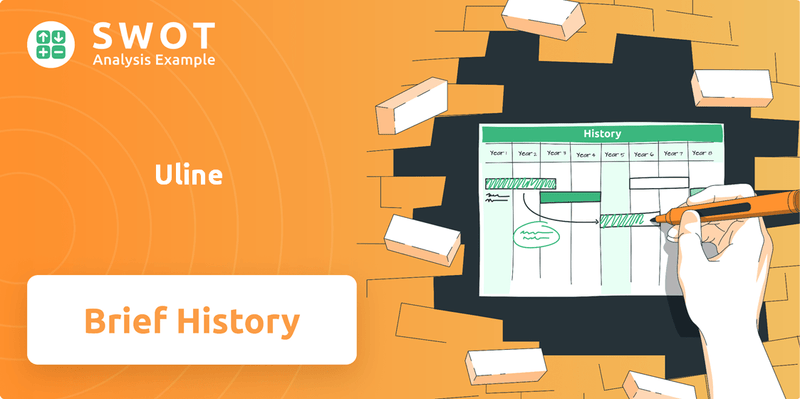
The Uline company's history began in 1980 with Liz and Dick Uihlein, who started with a simple yet effective concept: providing shipping supplies with same-day shipping. This focus on efficiency and customer service quickly set them apart. Today, Uline's extensive product catalog, including everything from boxes and tape to material handling equipment, serves businesses across North America. Understanding Uline's Uline SWOT Analysis can offer deeper insights into its strategic moves.
What is the Uline Founding Story?
The story of the Uline company began on July 1, 1980. It was founded by Liz and Dick Uihlein, who saw a need for readily available shipping supplies with quick delivery. This marked the start of a business that would change how companies sourced packaging materials.
The Uihleins started their business from their basement in Waukegan, Illinois. They used their own savings to get the company off the ground. They saw that businesses often struggled with delays and limited choices when getting packaging materials. The name 'Uline' came from combining their last name with 'line,' which represented their product offerings.
Liz Uihlein's experience in direct marketing helped them create a catalog-based business model. This model allowed them to offer a wide range of products directly to customers. Dick Uihlein's business and operational skills were key to overcoming the logistical challenges of their promise of fast delivery. Their initial product line included shipping boxes and packaging tape, with a focus on immediate availability and same-day shipping.
Uline's early days involved a focus on solving the common problems businesses faced when sourcing shipping supplies.
- The company started with a simple catalog and a commitment to fast delivery.
- Liz Uihlein's marketing skills and Dick Uihlein's operational expertise were crucial.
- Initial products included shipping boxes and packaging tape.
- The business model was designed to bypass traditional distributors.
Uline SWOT Analysis
- Complete SWOT Breakdown
- Fully Customizable
- Editable in Excel & Word
- Professional Formatting
- Investor-Ready Format
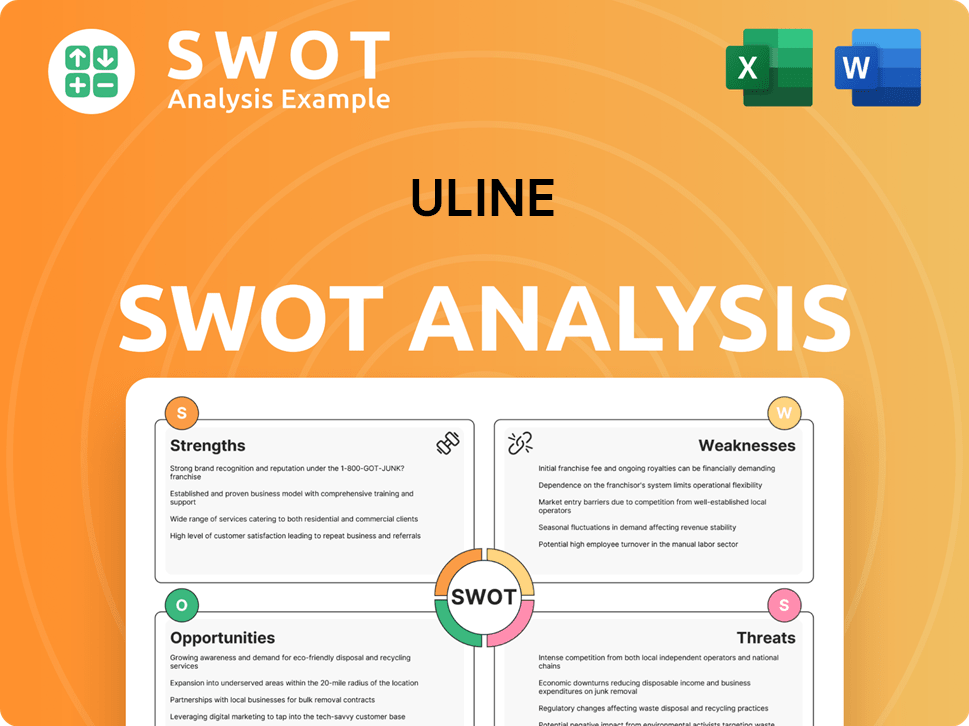
What Drove the Early Growth of Uline?
The early growth of the company, a key part of its Uline history, was marked by a strong focus on customer service, product diversification, and geographical expansion. Founded in 1980, the company quickly broadened its product offerings beyond initial shipping supplies. This expansion was fueled by direct customer feedback and a deep understanding of business needs, contributing to its early success. The company's commitment to in-stock availability and same-day shipping became a significant competitive advantage, attracting a growing customer base.
The company's product catalog expanded rapidly, moving beyond basic shipping supplies to include a wide range of packaging materials, industrial, and janitorial supplies. This diversification strategy, a core element of the Uline products approach, was directly influenced by customer needs and market demands. The Uline company adapted its offerings to meet the evolving needs of its expanding customer base, solidifying its position in the market.
Early distribution was centered around strategically located distribution centers across the United States to ensure rapid delivery. By the 1990s and early 2000s, Uline expanded into Canada and Mexico, establishing new distribution centers and sales operations. This expansion, a key part of Uline's growth and expansion, allowed the company to serve a broader market.
Initial team expansion was organic, with early hires focusing on warehouse operations and customer service. As operations grew, the company established its first dedicated warehouse facilities, moving beyond the initial basement operation. This expansion was crucial for maintaining its promise of rapid delivery. The company's growth also involved significant investment in its distribution network, a key aspect of the Uline distribution strategy.
The company has largely maintained its private ownership, avoiding major capital raises through external funding rounds. This approach allowed the Uihleins to maintain full control over the company's strategic direction. Reinvesting earnings fueled growth, prioritizing long-term stability and customer satisfaction over short-term financial pressures. This financial strategy has been a key factor in the company's sustained success. To learn more about their target market, you can read about the Target Market of Uline.
Uline PESTLE Analysis
- Covers All 6 PESTLE Categories
- No Research Needed – Save Hours of Work
- Built by Experts, Trusted by Consultants
- Instant Download, Ready to Use
- 100% Editable, Fully Customizable
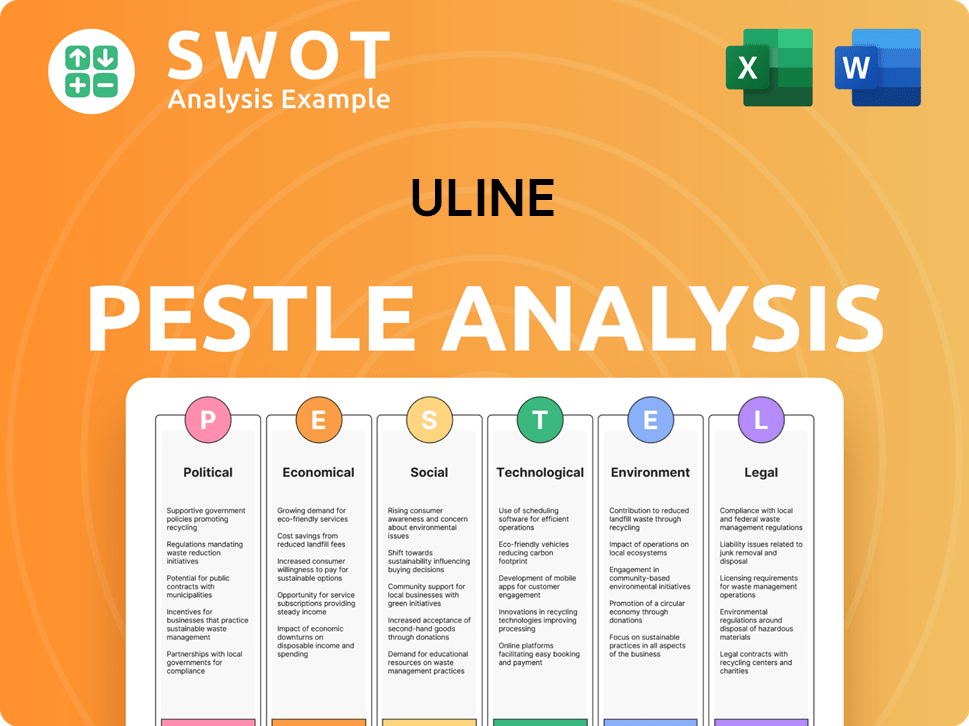
What are the key Milestones in Uline history?
The Uline company has a rich history marked by significant milestones, innovations, and challenges that have shaped its trajectory in the shipping and packaging industry. Understanding the Uline history provides insights into its growth and adaptability.
| Year | Milestone |
|---|---|
| 1980 | Uline was founded by Richard and Elizabeth Uihlein, initially selling shipping supplies. |
| 1980s | The company expanded its product offerings and distribution network significantly. |
| 1990s | Uline's growth accelerated with the introduction of its extensive catalogs and expanded product lines. |
| 2000s | Uline established a strong online presence and continued to expand its distribution centers across North America. |
| 2020s | Uline continues to grow, with a focus on e-commerce and expanding its global footprint. |
A key innovation for the Uline company was its pioneering use of comprehensive product catalogs, which became a hallmark of its marketing strategy. The company also innovated in its logistics and distribution, investing heavily in state-of-the-art warehouses and inventory management systems to ensure its promise of same-day shipping could be consistently met.
The extensive product catalogs were a primary marketing tool, showcasing a vast array of products to simplify the procurement process for customers.
Uline invested heavily in state-of-the-art warehouses and inventory management systems to ensure its promise of same-day shipping could be consistently met, with over a dozen distribution centers across North America.
Uline developed a comprehensive e-commerce platform that mirrored the breadth of their catalog, allowing customers to easily order online.
Throughout its history, Uline has faced challenges inherent in a competitive market, including economic downturns and the rise of e-commerce. The company has also navigated public scrutiny regarding its political contributions and workplace culture, which have at times presented reputational challenges.
Uline operates in a highly competitive market, facing competition from both large and small players in the shipping supplies industry.
Economic downturns can impact demand for shipping supplies, requiring Uline to adapt its strategies to maintain profitability.
The rise of e-commerce necessitated a strong online presence, requiring Uline to invest in its digital platform to remain competitive.
Uline Business Model Canvas
- Complete 9-Block Business Model Canvas
- Effortlessly Communicate Your Business Strategy
- Investor-Ready BMC Format
- 100% Editable and Customizable
- Clear and Structured Layout
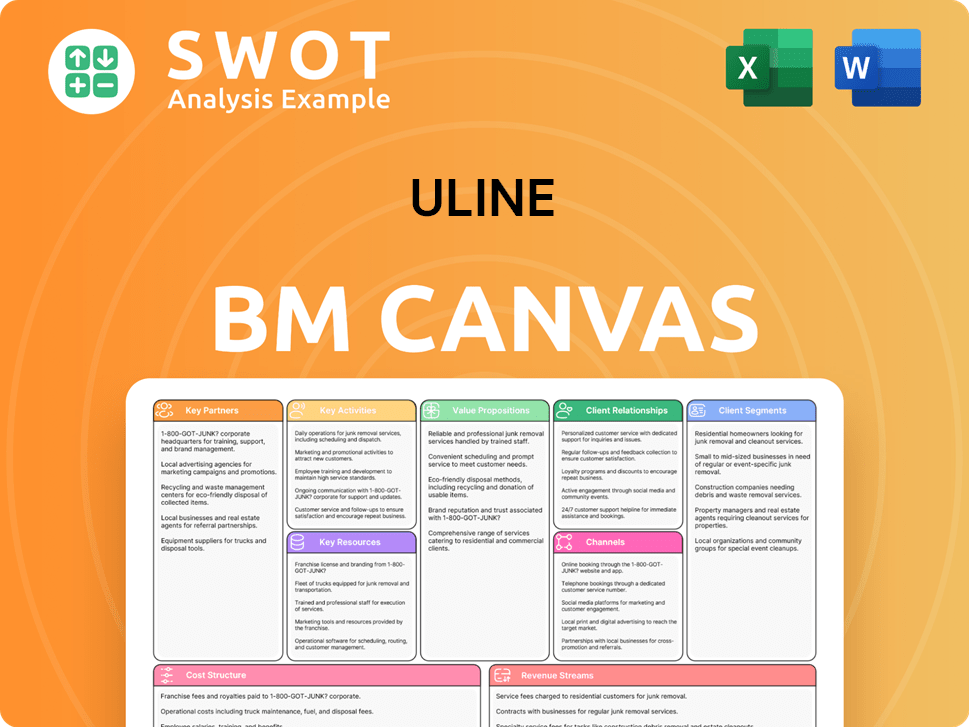
What is the Timeline of Key Events for Uline?
The Uline company, a leading distributor of shipping, industrial, and packaging materials, has a rich history marked by strategic growth and adaptation. Founded in 1980 by Liz and Dick Uihlein, the company has evolved from a small operation to a major player in the industry, consistently expanding its reach and product offerings to meet the needs of businesses across North America and beyond.
| Year | Key Event |
|---|---|
| 1980 | Uline was founded in Waukegan, Illinois, by Liz and Dick Uihlein. |
| 1980s | Rapid expansion of the product catalog and establishment of initial distribution centers across the United States marked this decade. |
| 1990s | Uline expanded its operations into the Canadian market. |
| Early 2000s | The company continued its geographical expansion, entering the Mexican market. |
| 2000s | Significant investments were made in Uline's e-commerce platform to complement its traditional catalog sales. |
| 2010s | The distribution network grew to encompass over 13 locations throughout North America. |
| 2020 | Uline celebrated its 40th anniversary, solidifying its position as a leading distributor. |
| 2023 | Uline opened new distribution centers and expanded existing ones to meet growing demand. |
| 2024-2025 | Uline continues to focus on supply chain optimization and expanding product offerings, with reported revenue exceeding $7 billion. |
Uline is expected to continue expanding its distribution network, which currently includes over a dozen locations across North America. This expansion will focus on enhancing delivery speed and reach, crucial for meeting customer demands in a timely manner. Ongoing investments in new facilities and technology are key components of this strategy, ensuring Uline can efficiently serve its growing customer base.
The company will likely further diversify its product offerings to cater to evolving business needs. This includes a focus on sustainable packaging solutions and automation equipment for warehouses. By expanding into these areas, Uline aims to provide comprehensive solutions that align with industry trends and customer preferences, boosting its competitive edge.
Uline is likely to prioritize supply chain optimization to improve efficiency and reduce costs. This may involve leveraging advanced technologies and data analytics to streamline logistics and inventory management. By optimizing its supply chain, Uline aims to maintain competitive pricing and ensure reliable product availability for its customers, strengthening its market position.
With its strong infrastructure and customer base, Uline is well-positioned to maintain its leadership in the industrial and packaging supply sector. The company is expected to continue investing in innovation, particularly in areas such as e-commerce and sustainable products. This commitment to innovation will help Uline meet the changing needs of its customers and stay ahead of the competition.
Uline Porter's Five Forces Analysis
- Covers All 5 Competitive Forces in Detail
- Structured for Consultants, Students, and Founders
- 100% Editable in Microsoft Word & Excel
- Instant Digital Download – Use Immediately
- Compatible with Mac & PC – Fully Unlocked
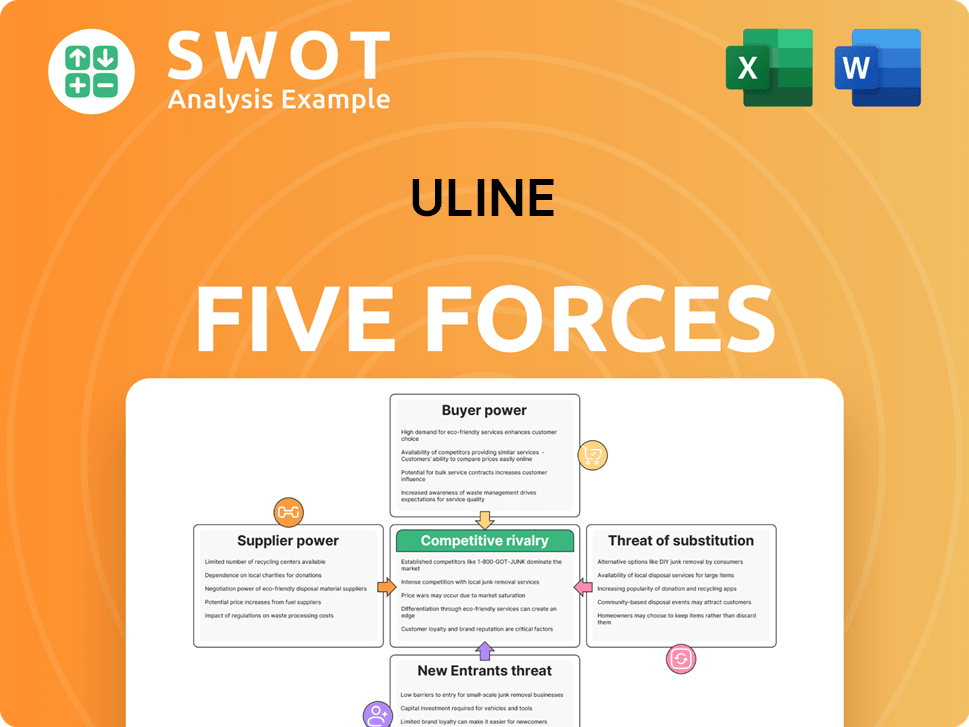
Related Blogs
- What is Competitive Landscape of Uline Company?
- What is Growth Strategy and Future Prospects of Uline Company?
- How Does Uline Company Work?
- What is Sales and Marketing Strategy of Uline Company?
- What is Brief History of Uline Company?
- Who Owns Uline Company?
- What is Customer Demographics and Target Market of Uline Company?
Disclaimer
All information, articles, and product details provided on this website are for general informational and educational purposes only. We do not claim any ownership over, nor do we intend to infringe upon, any trademarks, copyrights, logos, brand names, or other intellectual property mentioned or depicted on this site. Such intellectual property remains the property of its respective owners, and any references here are made solely for identification or informational purposes, without implying any affiliation, endorsement, or partnership.
We make no representations or warranties, express or implied, regarding the accuracy, completeness, or suitability of any content or products presented. Nothing on this website should be construed as legal, tax, investment, financial, medical, or other professional advice. In addition, no part of this site—including articles or product references—constitutes a solicitation, recommendation, endorsement, advertisement, or offer to buy or sell any securities, franchises, or other financial instruments, particularly in jurisdictions where such activity would be unlawful.
All content is of a general nature and may not address the specific circumstances of any individual or entity. It is not a substitute for professional advice or services. Any actions you take based on the information provided here are strictly at your own risk. You accept full responsibility for any decisions or outcomes arising from your use of this website and agree to release us from any liability in connection with your use of, or reliance upon, the content or products found herein.